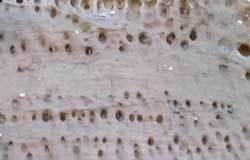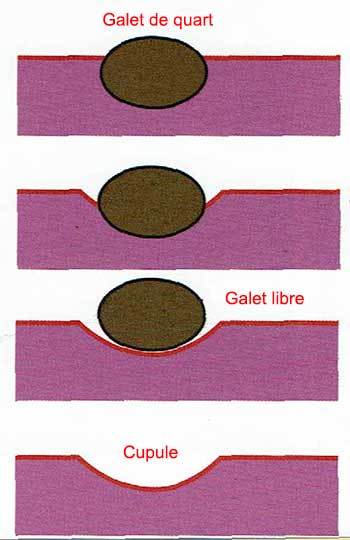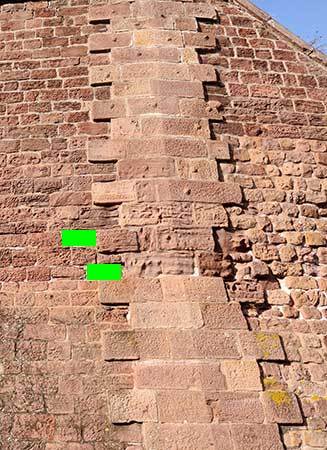[GBE20] Erosion du grès EarthCache
-
Difficulty:
-

-
Terrain:
-

Size:  (other)
(other)
Please note Use of geocaching.com services is subject to the terms and conditions
in our disclaimer.
[GBE20] Erosion du grès FR
Formation du grès:
Le grès est composé de sable (provenant de l'altération de roche) et d'un ciment qui relie les grains, ce ciment peut être de l'oxyde de fer, de la silice, de la calcite ou de l'argile.
Pour se former il y a 3 étapes:
- l'érosion de roches (pour avoir des grains de sable de taille comprise entre 2mm et 62 micron)
- le transport (le sable est emmené par les cours d'eau en fond de vallée)
- la sédimentation (pendant cette étape la pression exercé sur le sable enfoui à une certaine profondeur va consolider la roche)
Maintenant que vous savez comment se forme le grès nous allons parler de l'érosion du grès.
Erosion du grès:
Dans les parties verticales ou surplombantes des parois il peux se produire une érosion appelé "nid d'abeille". Cette érosion alvéolaire se situe sur les faces souvent plus tendre ou plus friable et crée des alvéoles qui peuvent faire plusieurs centimètres de diamètre.
Cette altération se crée par le vent, le soleil et la pluie, qui ont pour effet d'éroder les parties les plus faibles du rocher (le ciment), ce qui va libérer les grains de sable pour créer tous ces petit trous.

Sur les partie horizontale du grès on peux parfois remarquer des cuvettes (ou cupule).
Ce sont des dépressions hémisphériques de plusieurs centimètres de diamètres. Elles sont naturelles, car ce sont des concrétions sphériques riches en carbonate de calcium qui se dissolvent au contact de l'eau. Les grains de sables sont ainsi libérés plus rapidement formant comme un trou dans les rochers. Le phénomène d'érosion s'amplifie ensuite car la végétation stagnante à l'intérieur, comme les feuilles mortes ou aiguilles de conifères, génère de l'acidité.

Question:
Vous êtes actuellement devant un mur construit en grès, sur certain bloc vous pouvez observer un type d'érosion.

Question 1: d'après le descriptif et vos observations quelle type d'érosion pouvez vous observer sur les blocs cachés de la photo ?
Question 2: d'après vous l'érosion a-t'elle eu lieu avant ou après la pose de ce bloc pour la construction du mur ?
Loguez cette cache "Found it" et envoyez-moi vos propositions de réponses aux questions ci-dessus soit via mon profil, soit via la messagerie geocaching.com (Message Center), et je vous contacterai en cas de problème."
[GBE20] Sandstein-Erosion DE
Sandstein-Bildung :
Sandstein besteht aus Sand (aus der Gesteinsverwitterung) und einem Zement, der die Körner miteinander verbindet. Dieser Zement kann aus Eisenoxid, Kieselerde, Kalzit oder Ton bestehen.
Die Ausbildung erfolgt in 3 Schritten:
- Erosion von Felsen (Sandkörner mit einer Größe zwischen 2 mm und 62 Mikron).
- Transport (Sand wird von den Flüssen in der Talsohle mitgeführt).
- Sedimentation (während dieser Phase wird der Druck, der auf den in einer bestimmten Tiefe vergrabenen Sand ausgeübt wird, das Gestein verfestigen)
Da Sie nun wissen, wie Sandstein entsteht, werden wir über die Sandstein-Erosion sprechen.
Sandstein-Erosion :
In den senkrechten oder überhängenden Teilen der Wände kann es zu einer Erosion kommen, die als "Wabenbildung" bezeichnet wird. Diese Alveolarerosion befindet sich an den zarten oder brüchigeren Seiten und schafft Alveolen, die mehrere Zentimeter im Durchmesser betragen können.
Diese Verwitterung wird durch Wind, Sonne und Regen erzeugt, der die schwächsten Teile des Gesteins (den Zement) erodiert und die Sandkörner freisetzt, um all diese kleinen Löcher zu schaffen.

Auf den horizontalen Teilen des Sandsteins kann man manchmal Schüsseln (oder Kuppel) erkennen.
Das sind halbkugelförmige Vertiefungen von mehreren Zentimetern Durchmesser. Sie sind natürlich, denn es handelt sich um kugelförmige Konkremente, die reich an Kalziumkarbonat sind und sich bei Kontakt mit Wasser auflösen. Die Sandkörner werden so schneller freigesetzt und bilden ein Loch in den Felsen. Das Erosionsphänomen wird dann verstärkt, weil die stagnierende Vegetation im Inneren, wie z.B. abgestorbene Blätter oder Koniferenznadeln, Säure erzeugt.

Frage:
Sie befinden sich derzeit vor einer in Sandstein gebauten Mauer, auf einigen Blöcken kann man eine Art Erosion beobachten.

Frage 1: Welche Art von Erosion können Sie nach der Beschreibung und Ihren Beobachtungen an den versteckten Blöcken im Bild beobachten?
Frage 2: Fand die Erosion Ihrer Meinung nach, vor oder nach, der Verlegung dieses Blocks für den Bau der Mauer statt?
Loggen Sie sich diesen Cache als "Foundit" ein und senden Sie mir Ihre Antwortvorschläge zu den oben genannten Fragen entweder über mein Profil oder über geocaching.com (Message Center), und ich werde Sie kontaktieren, wenn es ein Problem gibt".
[GBE20] Sandstone erosionEN
Sandstone formation:
Sandstone is composed of sand (from weathering rocks) and a cement that binds the grain together. This cement can be iron oxide, silica, calcite or clay.
There are 3 steps:
- rock erosion (size and grains between 2 mm and 62 microns).
- transport (sanded by rivers at the bottom of the valley).
- sedimentation (during this stage, the pressure exerted on the sand buried at a certain depth will consolidate the rock).
Now that you know how sandstone was formed, let's talk about the erosion of sandstone.
Sandstone erosion:
In the vertical or overhanging parts of the wall, it can be called "honeycomb". This alveolar erosion is located on the softer or more fragile faces and creates alveoli which can be several centimeters in diameter.
This alteration created by the wind, the sun and the rain, which is the weakest among the lower parts of the cement (the cement), releases the grains of sand and creates all these small holes.

On the horizontal parts of the sandstone, we can sometimes notice bowls (or cups).
These are hemispherical deformations of several centimeters in diameter. They are natural because they are rich in spheres of calcium carbonate which dissolve on contact with water. The grains of sand are released more quickly, forming a hole in the rocks. The erosion phenomenon is then amplified because the stagnant vegetation inside, like dead leaves or conifer needles, generates acidity.

Question:
You are currently in front of a wall built in sandstone, on some blocks you can observe a type of erosion.

Question 1: According to the description and your observations, what kind of erosion can you observe on the hidden blocks in the picture?
Question 2: In your opinion, did the erosion take place before or after the block was placed for the construction of the wall?
Log in to this "Foundit" cache and send me your suggested answers to the above questions either via my profile or via geocaching.com (Message Center), and I will contact you if thereis a problem."
Additional Hints
(No hints available.)